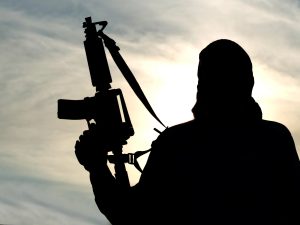A week before Hay’at Tahrir Al-Sham (HTS) toppled Bashar al-Assad’s regime in Syria, the chief of the Turkistan Islamic Party (TIP), also known as the East Turkistan Islamic Movement, Abdul Haq Turkistani, warned, “The Chinese disbelievers will soon taste the same treatment that the disbelievers in [Syria] have tasted, if God wills.”
When the HTS under Ahmed al-Shara’s command entered Damascus after the stunning 11-day offensive, it was accompanied by Uyghur, Central Asian, and Caucasian terrorist fighters. They were pivotal in HTS’ victory over the Assad regime. As many as 1,100 Uyghurs lost their lives while fighting the Assad regime on the HTS’ side.
Uyghurs are a predominantly Muslim ethnic group native to the Xinjiang region of China. Uyghur fighters started to arrive in Syria in 2012-2013 through Turkiye and Southeast Asia and clustered around the HTS-governed Idlib province. In total, about 15,000 Uyghurs reside in Syria, including 3,500 fighters who were recently incorporated into the Syrian military’s 84th division.
The battle-hardened Uyghur militants have ambitions beyond Damascus. Following the HTS’ victory in Syria, the TIP is biding its time to return to Xinjiang and relaunch its separatist campaign to create a Shariah state, East Turkistan. However, reentering China’s well-guarded borders will be quite challenging. Hence, the TIP could reposition itself in Afghanistan and Central Asia to target the Belt and Road Initiative.
The post-Assad order in Syria, despite diplomatic and financial support by regional and international actors, is far from stable. The HTS’ interim regime is navigating a complex and fractured ethnic and sectarian landscape in Syria amid regional turmoil in the Middle East. The Islamic State (IS) terrorist group is exploiting the Syrian regime’s vulnerabilities to resurge. It has claimed responsibility for two attacks in Syria since Assad’s fall, including one on the Syrian government forces. Against this backdrop, the incorporation of TIP militants into the Syrian military is fraught with multiple risks.
Though Abdulaziz Dawood Khudaberdi, also known as Zahid, is the TIP’s commander in Syria, Uyghur militants remain beholden to the commands of the terror group’s overall leader, Abdul Haq Turkistani, who resides in Afghanistan. He enjoys close links with the Taliban, al-Qaida, Tehreek-e-Taliban Pakistan, Jamaat Ansarullah, and the Islamic Movement of Uzbekistan.
According to a February 2025 U.N. report, there are between 500 and 1,200 TIP fighters in Afghanistan, and the Taliban have kept a tight leash on them. However, their numbers can swell very quickly if they start pouring in large numbers from Syria on Abdul Haq’s call to plan the next big move.
Reportedly, some TIP militants, along with Central Asian terrorists, have relocated from Syria to Afghanistan’s Panjshir valley along the Uzbek and Tajik borders. In Afghanistan, the TIP shares local headquarters and training camps with these militant networks in Balkh, Badakhshan, Kunduz, Kabul, and Baghlan provinces.
The Taliban have used TIP fighters in northern Afghanistan to fight the growing influence of their ideological rival, the Islamic State of Khorasan Province (ISKP), as it tried to recruit disgruntled elements of the Taliban-aligned groups to expand its regional footprint into Central Asia. It bears mention that ISKP has been trying to recruit TIP militants under a “Uyghur team.” If the Taliban do not ease their control on the TIP, the terror group’s angry members could join ISKP, which has been regularly churning out anti-China propaganda in a bid to win their attention and sympathies.
The TIP’s long history of operating in the Afghanistan-Pakistan and Central Asian regions, and its cross-cutting linkages with a plethora of terrorist groups, make it a major security challenge for regional states. The combat experience the TIP gained in Syria will make it attractive to regional terrorist networks to benefit from its operational and strategic skills. According to the U.N. report, the TIP is continuing its recruitment campaign targeting multiple nationalities in Afghanistan in a bid to internationalize. It is expanding the scope of its activities and operational bases under a long-term plan to infiltrate Central Asia.
In June, the Syrian Defense Ministry compelled the TIP to announce its disbandment. However, in the absence of transparent and credible monitoring mechanisms, it is difficult to measure the TIP’s compliance with such declarations. To emphasize Syrian resolve not to support foreign terrorist campaigns, President Muhammad al-Shara issued a statement maintaining, “I sympathize with them (Uyghurs), but their struggle against China is not ours.” These two moves were preceded by the TIP’s new charter in March, announcing a return to its original name, the East Turkistan Islamic Party. Critically, the new charter strikes a nationalist tone with a Xinjiang-centric focus, a lesson the TIP has learned from the Taliban and HTS’ successful models in Afghanistan and Syria.
As the new Syrian government is grappling with a plethora of internal and external political and security challenges while also trying to get the Syrian economy off the ground, it is too fragile to take any meaningful action against the TIP. In fact, a crackdown against the TIP could push the group’s angry elements into the fold of the IS, its arch nemesis.
Therefore, international sanctions through redesignation of the TIP as a Foreign Terrorist Organization (FTO) could be a more effective way of containing the group and curtailing its movement from Syria to Afghanistan. The U.S. recently designated the Baloch Liberation Army and its alias, the Majeed Brigade, as FTOs in a bid to win China’s counterterrorism cooperation against common terrorist threats, despite ongoing geopolitical rivalry. The same step against the TIP will go a long way in cementing China’s counterterrorism cooperation with the U.S. against common terrorist threats.




























